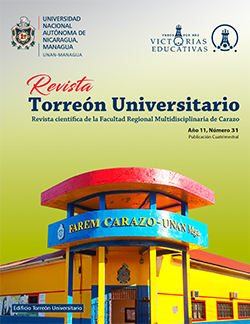Determination of Helicobacter pylori antigen in adults in low socio-economic conditions in a neighborhood of Juigalpa
DOI:
https://doi.org/10.5377/rtu.v11i31.14225Keywords:
adult, antigen, determination, Helicobacter pylori, immunochromatographyAbstract
Helicobacter pylori, is a negative gram bacterium capable of surviving gastric acidity causing chronic gastritis, peptic ulcer, and gastric cancer. The techniques used for the detection of this bacterium are divided into invasive and non-invasive, which provide a reliable diagnosis for the population, (Cruz, Guillén, & Martínez, 2015, p. 15)
The research was quantitative, descriptive, and cross-sectional. The objective of the study was to determine H pylori infection in adults in low socio-economic conditions aged 18 to 45 years in the San Antonio neighborhood of Juigalpa. The sample was 29 participants, to whom a questionnaire and the immunochromatographic test for the detection of the antigen of the bacterium were applied. The information was processed in SPSS v.21.
The results found were: 65.5% of positive cases, overcrowding in 44.8%, and 37.9% had no knowledge about the bacteria, 100% used to eat food outside the home and 93.1% had good hygienic-eating habits at home. When associating the symptoms with the presence of H. pylori antigen, a predominance of symptomatic infection was evidenced between 26.3 and 78.9%, except for heartburn in 100%.
In short, H. pylori infection is and will continue to be one of the most frequent health problems. Ignorance about the infection and food outside the home plays a fundamental role in the acquisition of it. Using diagnostic methodologies such as that applied in this investigation can allow the more global monitoring of the infection, both in symptomatic and asymptomatic patients.
Downloads
References
Bermúdez , L., Torres, L., & Rodríguez, B. (2009). Métodos para la detección de la infección por Helicobacter pylori. Scielo, 48(1), 1-14. Obtenido de http://scielo.sld.cu/pdf/med/v48n1/med07109.pdf
Cano, A., & colaboradores. (2018). El abordaje, las actitudes y el conocimiento acerca de Helicobacter pylori. Revista de Gastroenterología de México, 86(1), 16-24. Obtenido de http://www.revistagastroenterologiamexico.org/es-pdf-S0375090617300435
Castro, W., & Saldaña, M. (2015). Helicobacter pylori en heces, detección con portadores asintomáticos de 30 a 40 años comunidad San Gregorio Cantón Babahoyo los Ríos primer semestre 2015 (Tésis monográfica de grado). Los Ríos, Ecuador: Universidad Técnica de Babahoyo. Obtenido de http://dspace.utb.edu.ec/bitstream/handle/49000/1604/T-UTB-FCS-LAB-000058.pdf?sequence=1&isAllowed=y
CerTest BIOTEC. (2018). CERTEST H. pylori: One Step Helicobacter pylori Card Test (Versión 10). CerTest BIOTEC.
Cruz, E., Guillén, I., & Martínez, C. (2015). Detección de antígenos de Helicobacter pylori por el método de prueba rápida en estudiantes de bachillerato técnico vocacional atención primaria en salud del Instituto Nacional de Usulután, municipio y departamento de Usulután (Trabajo de grado). San Miguel, El Salvador: Universidad de El Salvador. Obtenido de http://ri.ues.edu.sv/id/eprint/10150/1/50108167.pdf
Flores, R., & López, M. (2009). Prevalencia de Helicobacter pylori en el servicio de endoscopia digestiva del centro de especialidades médicas Montoya y en Hopistal Bautista en el período enero a julio 2008 (Tesis). Managua, Nicaragua: UNAN-Managua. Obtenido de http://repositorio.cnu.edu.ni/Record/RepoUAM1575
Formento, T., Hernández, A., & Martínez, A. (2004). Helicobacter pylori. ELSEIVER, 23(11), 104-107. Obtenido de https://www.elsevier.es/es-revista-offarm-4-articulo-helicobacter-pylori-13069635
Frías, J., & Otero, W. (2017). Aspectos prácticos en métodos diagnósticos para la infección por Helicobacter pylori: una revisión narrativa. Revista de Gastroenterología Perú, 37(3), 246-253. Obtenido de http://www.scielo.org.pe/pdf/rgp/v37n3/a09v37n3.pdf
González, L., & Rodriguez, B. (2011). Patogénesis de la infección por Helicobacter pylori. Revista Cubana de Medicina, 50(4), 441-452. Obtenido de http://scielo.sld.cu/pdf/med/v50n4/med10411.pdf
Hernández, R., Fernández, C., & Pilar, B. (2014). Metodología de la Investigación (6 ed.). México: Mc Graw Hill.
Macenlle, R., Gayoso, P., Sueiro, R., & Fernández, J. (2006). Factores de riesgo asociados a la infección por Helicobacter pylori. Un estudio de base poblacional en la provincia de
Ourense. Scielo, 98(5), 336-340. Obtenido de https://scielo.isciii.es/pdf/diges/v98n5/es_original2.pdf
Obando, C. (2017). Frecuencia de Helicobacter pylori en estudiantes de primero a quinto año de la carrera de Microbiología del POLISAL –UNAN, Managua. Marzo –Octubre 2016 (Monografía). Managua, Nicaragua: UNAN-Managua, POLISAL Luis Felipe Moncada. Obtenido de https://repositorio.unan.edu.ni/8489/1/97635.pdf
Organización Mundial de Gastroenterología. (2010). Helicobacter pylori en los países en desarrollo. WGO. Obtenido de https://www.worldgastroenterology.org/UserFiles/file/guidelines/helicobacter-pylori-spanish-2010.pdf
Otero, W., Gómez, M., Otero, L., & Trespalacielos, A. (2018). Helicobacter pylori. Gastroenterología del Perú, 38(1), 54-63. Obtenido de http://www.scielo.org.pe/pdf/rgp/v38n1/a09v38n1.pdf
Otzen, T., & Manterola, C. (2017). Técnicas de muestreo sobre una Población a Estudio. Scielo, 35(1), 227-232. Obtenido de https://scielo.conicyt.cl/pdf/ijmorphol/v35n1/art37.pdf
Palomino, C., & Tomé, E. (2012). Helicobacter pylori: Rol del agua y los alimentos en su transmisión. Scielo, 25(2), 85-93. Obtenido de http://ve.scielo.org/pdf/avn/v25n2/art05.pdf
Piura, J. (2008). Metodología de la Investigación Científica (6 ed.). Managua, Nicaragua: Xerox.
Toledo, H., Defilippi, C., Madrid, A., Defilippi, C., Vallejos, C., Cáceres, D., & Venegas Mauricio. (2007). Prevalencia de la infección por Helicobacter pylori según ensayo de la ureasa en pacientes derivados a la Unidad de Endoscopía del Hospital Clínico de la Universidad de Chile. Revista Hospital Clínico Universidad de Chile, 189-193. Obtenido de http://repositorio.uchile.cl/bitstream/handle/2250/129066/Venegas_Mauricio_5.pdf?sequence=1
Published
How to Cite
Issue
Section
License
Copyright (c) 2022 National Autonomous University of Nicaragua, Managua.

This work is licensed under a Creative Commons Attribution-NonCommercial-NoDerivatives 4.0 International License.
The authors who publish in this journal agree to the following terms.
- The author or authors of the articles, essays or research grant the National Autonomous University of Nicaragua, Managua (UNAN-Managua) the editing rights (copyright) of the submitted work, therefore the University has the exclusive right to publish the article for the entire copyright period.
- These copyrights/authors authorize Torreón Universitario Magazine and the University to edit and disseminate/publish the article in said Magazine, including printed and electronic reproduction, storage, retrieval and any other type of publication, and sources of secondary information as services. of summaries and databases, they also empower it to protect the article against unauthorized use for dissemination by printed or electronic media (PDF, HTML, EPUB, XML or others).
License for use of content
The magazine uses the Creative Commons Attribution-NonCommercial-NoDerivs 4.0 International License.
Under this statement:

This journal is licensed under a Creative Commons Attribution-NonCommercial-NoDerivatives 4.0 International License. It can be copied, distributed and transmitted publicly as long as the author and source are cited (Revista Torreón Universitario), it should not be modified or used for any commercial purpose. The full license can be found at http://creativecommons.org/licenses/by-nc-nd/4.0/.



